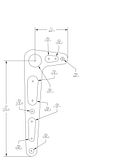paultsmith
Active Member
Here are the rearsets that I have been working on for a while.
You may have seen my cardboard mockup post here. http://dotheton.com/index.php?topic=7056.msg60372#msg60372
I finally got around to cutting out the rearsets and mounting them. The only change I needed to make was that I got rid of the bronze bushing and replaced it with a 3/8" ID bearing. The bushing wasn't allowing the lever to travel smoothly. The bearing is super smooth, used the same bearing from Fastenal as mentioned on a previous post.
Everything shown below in the photos was done with a jig saw, some files and sand paper drums mounted in my drill press. I bent the levers to solve my clearance issues and then went back to hack out the lightening holes. I didn't want to try to bend the lever with the holes in it, as it would have bent around the holes and in the wrong place.
The toe peg is just a sleeved bolt with the sleeve removed. I placed a piece of rubber fuel line over the sleeve. Very cheap. The pegs are BMX pegs with a 3/8 bolt.
I needed a bracket to mount these to the frame and since I wasn't planning on chopping anything off of the frame I planned on using the existing bolt holes for the passenger pegs and the old exhaust hanger mount. The bracket is just another piece of 1/4" aluminum. To get the "bling" factor (engine turning), I mounted a 3/8" wooden dowel in my drill press and dipped the end in valve grinding/lapping compound. I put light pressure on the aluminum and then continued moving the piece in 3/8" increments.
I just mounted the brake lever and bracket this evening, works great. Will take a photo and post it of the shifter and brake on the bike soon, but for now here are some images of the rearsets for the brakes before I mounted them.
Total price for the 2 levers and 2 brackets $75
Aluminum 4"x20" $25
Bearings $5
BMX Pegs $10
Aluminum Rod for Pushrods $5
Throttle Ball links $25
Misc (Bolts & fuel line) $5
This was my first time working with aluminum and was putting this off cause I thought it would end in a disaster. I was surprised how smooth everything went and will be fabricating some more for my next build.





You may have seen my cardboard mockup post here. http://dotheton.com/index.php?topic=7056.msg60372#msg60372
I finally got around to cutting out the rearsets and mounting them. The only change I needed to make was that I got rid of the bronze bushing and replaced it with a 3/8" ID bearing. The bushing wasn't allowing the lever to travel smoothly. The bearing is super smooth, used the same bearing from Fastenal as mentioned on a previous post.
Everything shown below in the photos was done with a jig saw, some files and sand paper drums mounted in my drill press. I bent the levers to solve my clearance issues and then went back to hack out the lightening holes. I didn't want to try to bend the lever with the holes in it, as it would have bent around the holes and in the wrong place.
The toe peg is just a sleeved bolt with the sleeve removed. I placed a piece of rubber fuel line over the sleeve. Very cheap. The pegs are BMX pegs with a 3/8 bolt.
I needed a bracket to mount these to the frame and since I wasn't planning on chopping anything off of the frame I planned on using the existing bolt holes for the passenger pegs and the old exhaust hanger mount. The bracket is just another piece of 1/4" aluminum. To get the "bling" factor (engine turning), I mounted a 3/8" wooden dowel in my drill press and dipped the end in valve grinding/lapping compound. I put light pressure on the aluminum and then continued moving the piece in 3/8" increments.
I just mounted the brake lever and bracket this evening, works great. Will take a photo and post it of the shifter and brake on the bike soon, but for now here are some images of the rearsets for the brakes before I mounted them.
Total price for the 2 levers and 2 brackets $75
Aluminum 4"x20" $25
Bearings $5
BMX Pegs $10
Aluminum Rod for Pushrods $5
Throttle Ball links $25
Misc (Bolts & fuel line) $5
This was my first time working with aluminum and was putting this off cause I thought it would end in a disaster. I was surprised how smooth everything went and will be fabricating some more for my next build.














